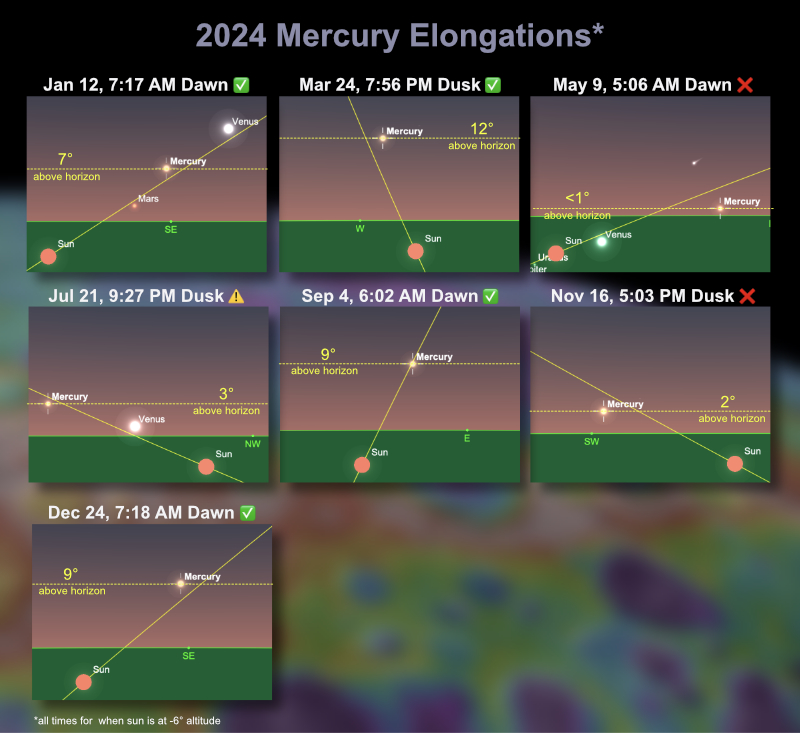| 2024: Great Opportunities to View Mercury (2023-11-27) ⬅︎ |
 |
Most stargazers have never seen Mercury because it is so close to the sun and difficult to view. The best times to try are at maximum elongations when Mercury appears furthest from the sun in our sky. There are two kinds of elongations depending on the side of the sun Mercury appears on:
Dawn Elongations occur when Mercury appears on the right (west) side of the sun. Mercury can be viewed for a short time after it rises and before the sun rises.
Dusk Elongations occur when Mercury appears on the left (east) side of the sun. Mercury can be viewed for a short time after the sun sets and before it sets.
Because Mercury orbits the sun so rapidly, it will have seven elongations in 2024 alternating between dawn and dusk. However only three of them will be good for viewing and a fourth one will be kind of good. This is because Mercury's altitude above the horizon during its short viewing window can vary a lot due to Earth's tilt and Mercury's elliptical orbit. The diagram above shows Mercury's peak altitude at each of the elongations.
2024 Maximum Elongations (Starry Hill region)
✅ Jan 12: 7° peak altitude, dawn, 8 days of Easy viewing (Jan 3-10) more details
✅ Mar 24: 12° peak altitude, dusk, 17 days of Easy viewing (Mar 13-Apr 1) more details
❌ May 9: <1° peak altitude, dawn , 0 days of Easy viewing more details
⚠️ Jul 21: 3° peak altitude, dusk, but 15 days of Moderate viewing (Jul 1-15) more details
✅ Sep 4: 9° peak altitude, dawn, 13 days of Easy viewing (Aug 30-Sep 11) more details
❌ Nov 16: 2° peak altitude, dusk, 0 days of Easy viewing more details
✅ Dec 24: 9° peak altitude, dawn, 14 days of Easy viewing (Dec 15-28) more details
For help in understanding angular distances (degrees), click here.
Here's a video that shows the path of Mercury about the Sun during 2024. At each elongation, notice if Mercury is left of the Sun (dusk viewing) or right of the Sun (dawn viewing). More importantly, at each elongation notice how high Mercury is above the ecliptic (the yellow line showing the plane of the solar system). The higher Mercury is at elongation, the easier it will be to view.
WARNING: since Mercury is so close to the sun in our sky, use great caution in using a telescope or binocular to view it, especially at dawn, when a rising sun may enter the field of view unexpectedly and cause severe eye damage.
Good luck in your efforts in viewing Mercury and joining the ranks of the few stargazers who have seen this elusive and small world! |
| |



